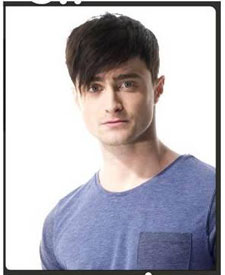 Based on how much Shakespeare that was being done in New York in 2013, one would never suspect that the Bard has been dead for nearly four hundred years. While Shakespeare in the Park is an annual summer tradition in New York, this year’s Love’s Labor Lost was just the tip of the iceberg for what has to have been the most Shakespeare-heavy year in New York in recent memory. Naturally, not all the productions were successful or well-received, but anyone who has any taste for Shakespeare could have found something to rave about on stage in New York in 2013.
Based on how much Shakespeare that was being done in New York in 2013, one would never suspect that the Bard has been dead for nearly four hundred years. While Shakespeare in the Park is an annual summer tradition in New York, this year’s Love’s Labor Lost was just the tip of the iceberg for what has to have been the most Shakespeare-heavy year in New York in recent memory. Naturally, not all the productions were successful or well-received, but anyone who has any taste for Shakespeare could have found something to rave about on stage in New York in 2013.
Of course, the most headline-grabbing production was far from the best. Despite its enduring popularity as required reading in middle schools across America, the last time Romeo and Juliet was produced on Broadway was a 1986 production at the Belasco Theatre that was played in repertory with As You Like It and Macbeth and produced by Joseph Papp and The Public Theater. The last production on its own was a 1977 Circle in the Square production. Nonetheless, the tragedy hasn’t been gone from New York stages for very long. Oscar Isaac and Lauren Ambrose starred in the 2007 Shakespeare in the Park production, there was a revival of the Romeo and Juliet inspired West Side Story on Broadway in 2009, and just in 2012 the Public Theater hosted a reading starring Kevin Kline and Meryl Streep. Perhaps that’s why the producers and five-time Tony Award nominee director David Leveaux decided to set their 2013 production apart by casting Romeo and Juliet as an interracial couple, with Lord of the Rings star Orlando Bloom making his Broadway debut as Romeo and Condola Rashad as Juliet. The staging had some modern elements, including the much-talked about arrival of Romeo on a motorcycle and a scene featuring a hot air balloon.
However, these elements were mostly seen as gimmicky by the critics, who panned the production across the board. Despite being a perfect destination for field trips for middle schools across the New York region, Romeo and Juliet had an average weekly attendance of 56% across its entire run and it closed on December 8, five weeks earlier than planned.
That wasn’t it for the star-crossed lovers. Though the Off-Broadway production of Romeo and Juliet presented by the Classic Stage Company, which featured Elizabeth Olsen as Juliet and T.R. Knight as Mercutio, completed its month-long run reviews were generally just as bad (the New York Post review called it an “inept, birdbrained concoction”). The production suffered from casting issues – Romeo was initially set to be portrayed by Finn Wittrock (who starred in the recent acclaimed production of Death of a Salesman on Broadway) and William Hurt was cast as the Friar, though both of them withdrew – which probably contributed to the production’s flaws. Curiously, its schedule coincided with the Broadway production, which is a head-scratcher because the two were compared in nearly every major review, mostly to the detriment of the Classic Stage Company production (which says a lot, because critics didn’t like the Broadway version either).
But Romeo and Juliet wasn’t the only Shakespeare tragedy that New Yorkers got a double dose of. Another one of Shakespeare’s most popular plays, Macbeth, had two Broadway productions this year. The first was Alan Cumming‘s unorthodox production that is essentially a one-man show as he nearly single-handedly performs an abridged version of the play as a patient in a mental asylum. Cumming’s production first ran in New York at the 2012 Lincoln Center Festival. The 2013 production at the Ethel Barrymore Theatre received generally strong reviews and solid ticket sales and actually extended its originally scheduled run by 12 performances. The production made additional headlines when it was one of two shows that pulled the free tickets offered to Tony Award voters after the production did not receive a single nomination. The lack of nominations and the ticket pulling were both considered surprises by many.
The second Macbeth was a more traditional production at Lincoln Center starring Ethan Hawke. This production had far more negative reviews than Cumming’s, but ticket sales have been nearly the same (Cumming’s sold 73% of an average weekly attendance while Hawke’s has sold 72% through December 29). It is scheduled to close on January 12. Much has been said about how the Hawke production focuses on the manipulation of the witches throughout the narrative. New Yorkers will get yet another dose of Macbeth this summer when Kenneth Branagh brings his acclaimed production to the Park Avenue Armory, which will be Branagh’s New York stage debut.
As one would suspect, there were other inventive Shakespeare productions in New York this year, though it seems just about everyone was on the same wavelength. London’s Donmar Warehouse brought its all-female production of Julius Caesar, which is set in a women’s prison, to Brooklyn’s St. Ann’s Warehouse. It received rave reviews from major critics. However, that wasn’t even the only acclaimed production of Julius Caesar in Brooklyn this year. The Royal Shakespeare Company presented a production at the Brooklyn Academy of Music that was just as innovative. Set in present day Africa, it featured an all-black cast and was just as well-received at the Donmar Warehouse production. Another production by Smith Street Stage at Carroll Park took a combined approach: it also cast a female (Sarah Dacey Charles) in the lead role in a contemporary setting.
If that seems like too much Julius Caesar for one year, there were plenty of other Shakespeare choices all around New York. The Public Theater’s “Mobile Shakespeare Unit” performed Much Ado About Nothing in several venues throughout New York City in November and December, and finally returned “home” to the Public Theater for a brief run. The Public Theater also presented The Comedy of Errors earlier this year. Julie Taymor opened the new Brooklyn location of Theatre for a New Audience with a production of A Midsummer Night’s Dream (which ends its run on January 12). The Brooklyn Academy of Music is also presented an extremely experimental one-person version of Hamlet titled A Piece of Work (the role is alternated by Scott Shepherd or Joan MacIntosh) that was rewritten by a computer in December. A more traditional version of Hamlet was performed earlier this year by The Seeing Place in repertory with Rosencrantz and Guildenstern Are Dead, though not without the company’s usual flair for its high-quality actor-driven performances.
But it seems one Shakespeare production stood head and shoulders above all others in 2013 in New York. Actually, make that two productions, because Shakespeare’s Globe is performing Twelfth Night and Richard III starring Mark Rylance in repertory with a traditional all-male cast to universal acclaim. It’s difficult to find anyone who hasn’t loved the production – in fact, it’s even more difficult to find a ticket since nearly every performance has been sold out beyond capacity. If you haven’t seen either production yet, both are closing on February 16, extended two weeks from the original closing dates of February 1 and 2, respectively.
That means that Shakespeare’s Globe has already set a high bar for Shakespeare in New York in 2014. Besides the aforementioned production of Macbeth with Branagh and a production of of Antony & Cleopatra set to run at The Public Theater in February, it doesn’t seem like this year will be quite as Shakespeare saturated as 2013 in New York. After all, nobody wants to see a bunch of four hundred year-old plays go out of style because of overexposure, right?




actually 450…2014 is his 450th celebration in England
Yes, he was born 450 years ago as of 2014. But as I wrote, he has been DEAD nearly 400 years (398 years as of this April, to be exact!)
So we’re both right! Thanks for reading!